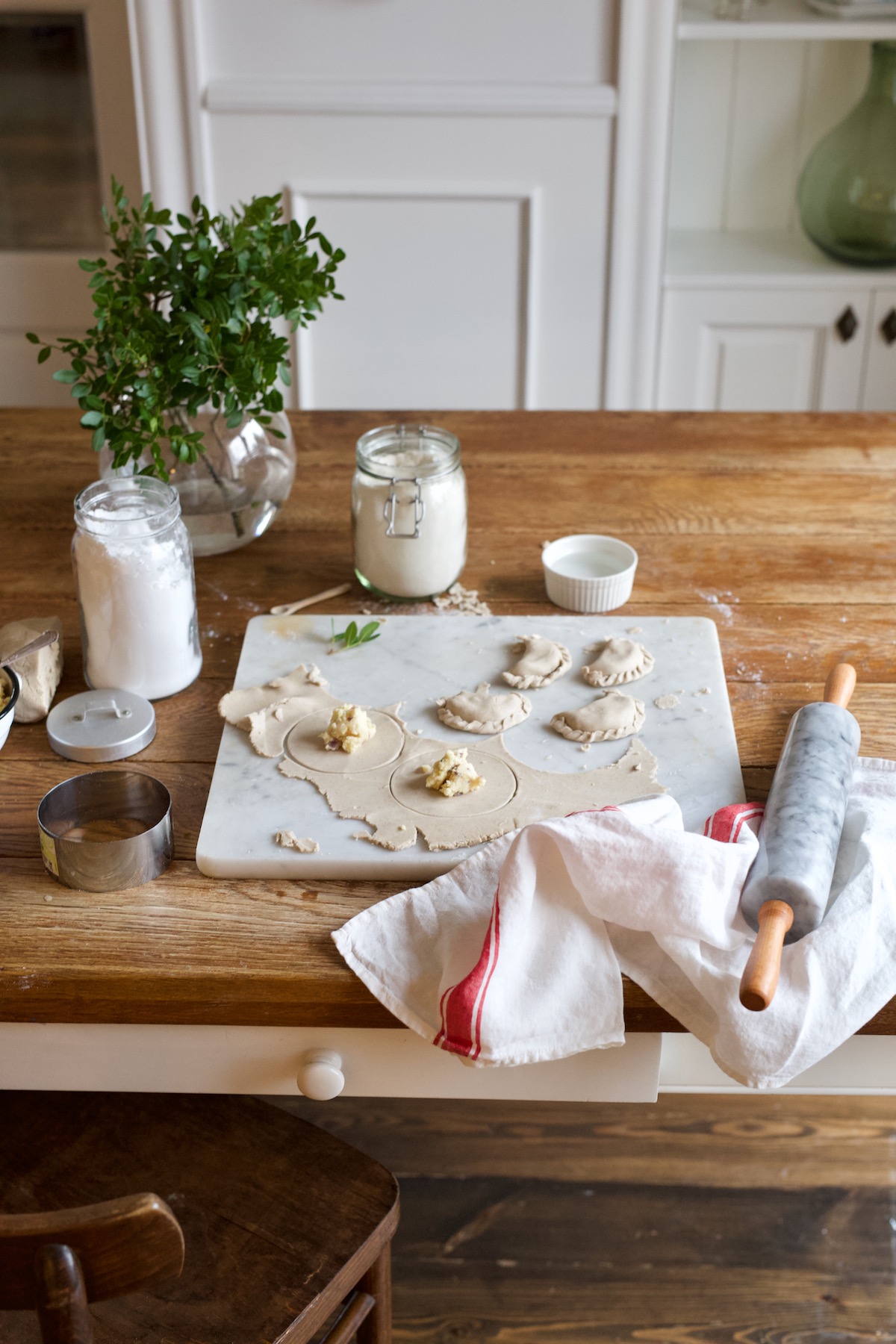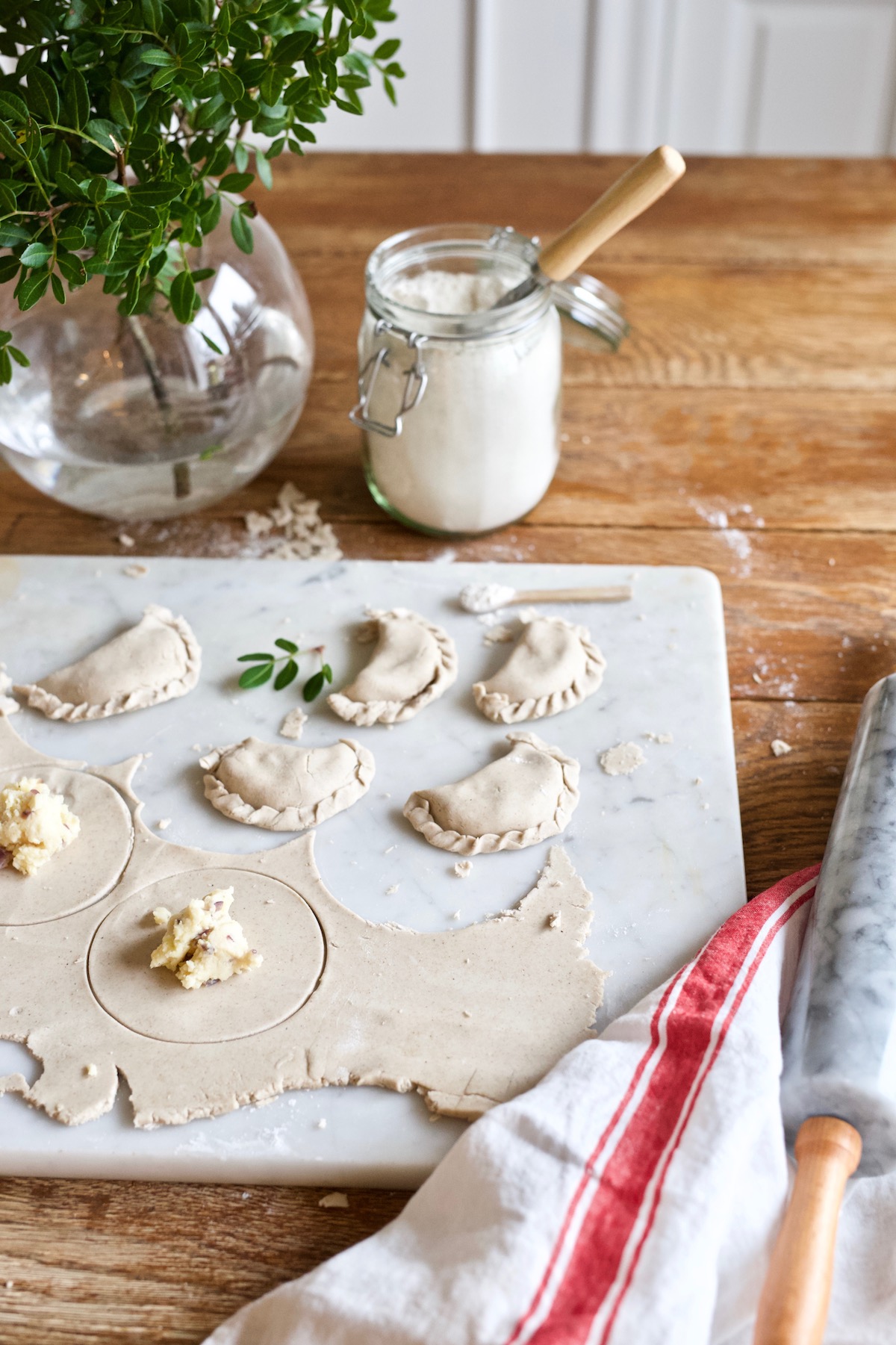
It’s not a whim or a short-term fashion that sparked the idea for today’s post. Already a long time ago I promised my readers (with whom I’ve been corresponding on the topic of gluten-free Christmas Eve) that I’d prepare a post with a gluten-free version of dumplings with potato and cottage cheese stuffing. As it turns out, there’s such a need among my readers so I’ve decided to get a slightly better preparation. I love dumplings – that’s something that you surely are aware of – and dumplings with potato and cottage cheese stuffing have a special place at our home. Instead of cottage cheese, I add sheep cheese and combine it with onion fried on butter and garlic with mashed potatoes. The stuffing shouldn’t be too dry so I add sour cream. However, the difficulty doesn’t lie in the preparation of the stuffing, but in the dough itself. In order to keep the appropriate dense texture, most of the recipes offer combining different flours (unfortunately, I’m not convinced by dumplings made with cassava or coconut flour – not in case of dumpling with potato and cottage cheese stuffing! :P). Therefore, I’ve decided to try out a mix of buckwheat flour and potato flour. After rolling it out, the dough is slightly more delicate in comparison to traditional dough prepared with the use of wheat flour; therefore, I pay particular attention to a quick forming of the dumplings to prevent them from drying out (then, the dumplings might become crumbly and start to fall apart; you can add some more oil if that’s the case with you). After cooking the dumplings, it’s important to dry them slightly in a pan with butter, owing to which they will acquire great smell and even better taste!
* * *
To nie fanaberia, ani krótkotrwała moda podpowiedziała mi temat dzisiejszego wpisu. Już dawno obiecałam moim Czytelnikom (z którymi koresponduję od kilku tygodnia w tematach bezglutenowej wigilii), że przygotuję wpis z wersją pierogów bezglutenowych. Jak się okazuje, rzeczywiście jest taka potrzeba, więc postanowiłam się nieco lepiej przygotować. Kocham pierogi – to zapewne wiecie – a ruskie, zasługują w naszym domu na specjalną uwagę. Zamiast twarogu dodaję bryndzę i łączę z przesmażoną na maśle cebulką i czosnkiem oraz tłuczonymi ziemniakami. Farsz nie powinien być zbyt suchy, więc dodaję kwaśną śmietanę. Trudność jednak nie polega w przygotowaniu farszu, lecz w samym cieście. Aby zachować wiążącą konsystencję, większość przepisów oferuje łączenie różnych mąk (do mnie niestety nie przemawiają pierogi z tapioki lub mąki kokosowej – nie przy ruskich! :p). Postanowiłam zatem wypróbować mąkę gryczaną z mąką ziemniaczaną. Po rozwałkowaniu, ciasto jest ciut delikatniejsze, od tego tradycyjnego z mąki pszennej, dlatego zwracam uwagę, żeby dość szybko formować pierogi i uniknąć przesuszenia (wówczas, mogą się kruszyć i rozpadać; można wtedy dodać więcej oleju). Po ugotowaniu, ważne, żeby podsmażyć trochę na maśle, dzięki czemu ładnie pachną i jeszcze lepiej smakują!

Ingredients:
(recipe for approx. 20-15 pieces)
dough:Approx. 250 g of buckwheat flour
150 g of potato flour
4-5 tablespoons of plant oil
250 ml of boiling water
filling:
approx. 500 g of peeled and cooked potatoes
2 red onions + 5-6 garlic cloves
250 g of sheep cheese
2-4 tablespoons of sour cream
sea salt / freshly ground pepper
* * *
Skład:
(przepis na ok. 20-15 sztuk)
ciasto:
ok. 250 g mąki gryczanej jasnej
150 g mąki ziemniaczanej
4-5 łyżek oleju roślinnego
250 ml wrzątku
farsz:
ok. 500 g obranych i ugotowanych ziemniaków
2 czerwone cebule + 5-6 ząbków czosnku
250 g bryndzy
3-4 łyżki kwaśnej śmietany
sól morska / świeżo zmielony pieprz

Directions:
1. Combine the flours while adding boiling water and oil little by little. When the ingredients are combined, knead the dough until smooth. Cover it with a linen table napkin.
2. In a hot pan with melted butter, fry chopped garlic and onion. When the ingredients become brownish, place them in a pot and add cooked potatoes and sheep cheese. Knead everything with a fork (of course, we can mash them beforehand). Season everything with sour cream, sea salt, and freshly ground pepper in the end.
3. Roll the dough out on the pastry board and cut out circular pieces (e. g. with the use of a glass). Place some filling in the middle of each piece. Fold the pieces in half. Use your finger to dab a little water around the edge of each piece before sealing. Cook the dumplings in a large pot with salted water until they flow out. Before serving, it's worth frying the dumplings on butter with some onion. Serve with sour cream.
* * *
A oto jak to zrobić:
1. Mąki łączymy ze sobą, dolewając stopniowo wrzątku i oleju. Kiedy składniki się połączą, zagniatamy ciasto, aby zrobiło się gładkie. Przykrywamy lnianą ściereczką.
2. Na rozgrzanej patelni na maśle, podsmażamy posiekany czosnek i cebulę. Gdy się zarumienią, przekładamy do garnka, dodajemy ugotowane ziemniaki i bryndze. Całość ugniatamy widelcem (oczywiście, wcześniej możemy ziemniaki przepuścić przez praskę). Na końcu doprawiamy śmietaną, solą morską i świeżo zmielonym pieprzem.
3. Ciasto rozwałkowujemy na stolnicy i wycinamy kółka (np. za pomocą szklanki). Na środku każdego kółka kładziemy gotowy farsz, zginamy w połowę. Przed sklejeniem warto zwilżyć brzegi wodą. Pierogi gotujemy w dużym garnku z osoloną wodą, do momentu aż wypłyną. Przed podaniem warto podsmażyć na maśle z cebulą. Podajemy z kwaśną śmietaną.
 Roll the dough out on the pastry board and cut out circular pieces (e. g. with the use of a glass). Place some filling in the middle of each piece. Fold the pieces in half. Use your finger to dab a little water around the edge of each piece before sealing.
Roll the dough out on the pastry board and cut out circular pieces (e. g. with the use of a glass). Place some filling in the middle of each piece. Fold the pieces in half. Use your finger to dab a little water around the edge of each piece before sealing.
* * *
Ciasto rozwałkowujemy na stolnicy i wycinamy kółka (np. za pomocą szklanki). Na środku każdego kółka kładziemy gotowy farsz, zginamy w połowę. Przed sklejeniem warto zwilżyć brzegi wodą.
 Cook the dumplings in a large pot with salted water until they flow out. Before serving, it's worth frying the dumplings on butter with some onion. Serve with sour cream.
Cook the dumplings in a large pot with salted water until they flow out. Before serving, it's worth frying the dumplings on butter with some onion. Serve with sour cream.
* * *
Pierogi gotujemy w dużym garnku z osoloną wodą, do momentu aż wypłyną. Przed podaniem warto podsmażyć na maśle z cebulą. Podajemy z kwaśną śmietaną.
 * * *
* * *









Komentarze